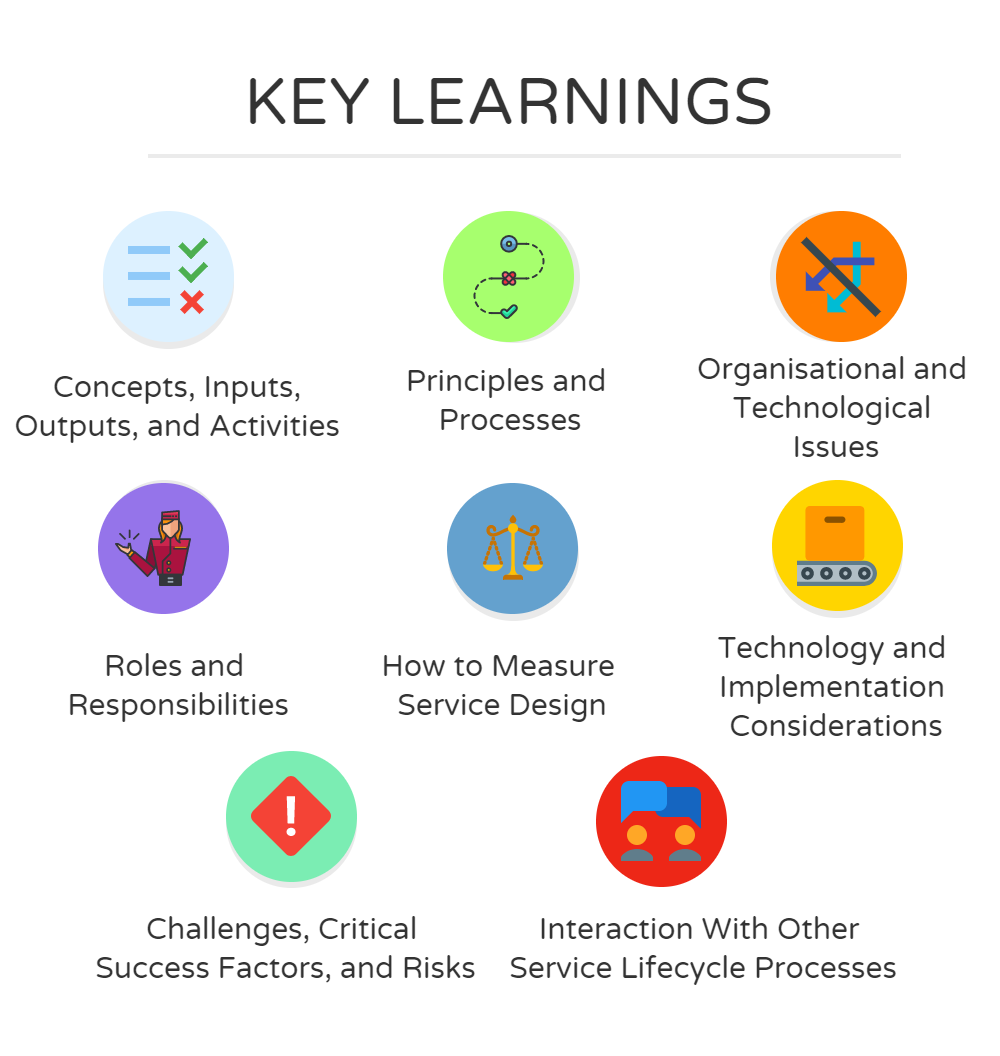Introduction: Service Design
- Define Service Design
- Key concepts and terminologies
- Scope and objectives of Service Design
- Service Design Processes
- Service Design value
- Fundamentals of Service Design
- Inputs and Outputs of Service Design
Introduction: Principles of Service Design
- Major aspects of Service Design
- Four Ps of Service Design
- Benefits Service Design approach
- Service and Business requirements
- Design Activities and its Constraints
- Principles of Server-Oriented Architecture
- Service Design Models
Introduction: Design Coordination Process
- Scope and Objectives
- Business value
- Basic concepts and terminologies
- Input, output, methods and activities
- Interfaces of process
- CSFs and KPIs
- Risks and Challenges
- Roles and Responsibilities
Introduction: Service Catalogue Management Process
- Scope and Objective
- Business value
- Basic concepts and terminologies
- Input, output, methods and activities
- Interfaces of process
- CSFs and KPIs
- Risks and Challenges
- Key Service Management Roles
Introduction: Service Level Management Processes
- Scope and Objective
- Business value
- Basic concepts and terminologies
- Input, output, methods and activities
- Interfaces of process
- CSFs and KPIs
- Risks and Challenges
- Key Service Management Roles
Introduction: Supplier Management Process
- Scope and Objective
- Business value
- Basic concepts and terminologies
- Input, output, methods and activities
- Interfaces of process
- CSFs and KPIs
- Risks and Challenges
- Key Service Management Roles
Introduction: Availability Management Processes
- Scope and Objective
- Business value
- Basic concepts and terminologies
- Input, output, methods and activities
- Interfaces of process
- CSFs and KPIs
- Risks and Challenges
- Key Service Management Roles
Introduction: Capability Management Process
- Scope and Objective
- Business value
- Basic concepts and terminologies
- Input, output, methods and activities
- Interfaces of process
- CSFs and KPIs
- Risks and Challenges
- Key Service Management Roles
Introduction: IT Service Continuity Management Process
- Scope and Objective
- Business value
- Basic concepts and terminologies
- Input, output, methods and activities
- Interfaces of process
- CSFs and KPIs
- Risks and Challenges
- Key Service Management Roles
Introduction: Process of Information Security Management
- Scope and Objective
- Business value
- Basic concepts and terminologies
- Input, output, methods and activities
- Interfaces of process
- CSFs and KPIs
- Risks and Challenges
- Key Service Management Roles
Introduction: Organizing Service Design
- Functional Role Analysis
- RACI Matrix in designing process
- Functions within Service Design stage
- Business Impact Analysis
Introduction: Technology and Implementation Analysis
- Process Implementation Practices
- Generic requirements for Technology
- Applying evaluation criteria for technology and processes
- Plan and implement Service Design Management Technologies
*After completing 2 days of classroom training and successfully passing your Foundation Exam, the third day of this course is a flexible exam preparation day to complete at your convenience in order to prepare you to take and pass your exam online.
We provide comprehensive support during the exam process to make the experience as simple as possible. This exam can be taken at a suitable time, subject to availability; online, anywhere.
Benefits of online exams include:
- Proven higher pass rates
- Quicker Results
- Save Travel Costs
- Flexibility
- Convenient
- Take your exam at your home, office, or work when you are ready






